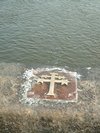John of Nepomuk
|
|
John_of_Nepomuk.jpg
John of Nepomuk (German: Johann von Nepomuk) or Johann Nepomucen (Czech: Jan Nepomucký) is the most popular national saint of Bohemia. By a legend that he was the confessor of the Queen of Bohemia and refused to divulge the secrets of the confessional, he has been made into the first martyr of the seal of confession and a patron against calumnies and, because of the manner of his death, against floods.
The historical starting-point of the Nepomuk legend is the person of John of Pomuk, a small market town of Bohemia later renamed Nepomuk, which belonged to the nearby Cistercian abbey. He was born probably about 1340 and studied first at the new University of Prague, then followed a course in canon law at the University of Padua. In 1393 he was made the vicar-general of John of Jenštejn, (1348-1400) Archbishop of Prague from 1378 to 1396. Among his contemporaries, the new vicar-general enjoyed no special reputation; he was rich, possessed houses, and lent money to noblemen and priests. In the same year, March 20 he was thrown into the river Vltava from Charles Bridge in Prague at the behest of Wenceslaus, Holy Roman Emperor and King of Bohemia.
The issue was an old one, and its peremptory solution was traditional (compare the Defenestrations of Prague). At issue was the appointment of a new abbot for the rich and powerful Benedictine Abbey of Kladrau (or Abbey of Kladruby), whose abbot was a territorial magnate whose resources would be crucial to Wenceslaus in his struggles with nobles. Wenceslaus at the same time was backing the Avignon papacy, whereas the Archbishop of Prague followed its rival, the pope at Rome. As the Hussite reform movement, denounced as "heresy" divided Bohemia, Archbishop John of Jenštejn ably represented the conservative or even reactionary faction of ecclesiastical universalism, which was not favourably inclined to any radical social changes. Contrary to the wishes of Wenceslaus, John confirmed the Archbishop's candidate for Abbot of Kladrau, and was thrown off the Charles Bridge at Prague on the Emperor's orders, March 20, 1393.
John of Nepomuk is seen by Catholics as a martyr to the cause of clerical immunity, by Romantic nationalists as a Czech martyr to Imperial interference, and by historians as a victim of a late version of the inveterate investiture controversy between secular rulers and the Catholic hierarchy.

The development and transformation of the legend can be traced through successive stages. The archbishop, who hastened to Rome soon after the crime, in his charge against Wenceslaus, called the victim a martyr; in the biography written a few years later miracles are already recorded by which the drowned man was discovered. The uncritical Bohemian annalists from the fourteenth to the sixteenth century fostered the fable. About the middle of the 15th century the statement appears for the first time that the refusal to violate the seal of confession was the cause of John's death. Two decades later (1471), the dean of Prague, Paul Zidek, makes Johanek the queen's confessor. The unscrupulous chronicler Wenceslaus Hayek, the "Bohemian Livy," speaks in 1541 (probably owing to carelessness in the use of his sources) of two Johns of Nepomuk being drowned; the first as confessor, the second for his confirmation of the abbot. The legend is especially indebted for its growth to the Jesuit Balbinus, the "Bohemian Pliny," whose services to the history of his country were so conspicuous that he was persecuted by the government, which preferred oblivion and silence. He was, however, as credulous as he was patriotic, and even became a forger to honor his saint. Although the Prague metropolitan chapter did not accept the biography dedicated to it, "as being frequently destitute of historical foundation and erroneous, a bungling work of mythological rhetoric," Balbinus stuck to it. In 1683 the Prague bridge was adorned with a statue of the saint, which has had numerous successors; in. 1708 the first church was dedicated to him at Königgrätz. Meanwhile, in spite of the objection of the Jesuits, the process was inaugurated which ended with his canonization. On May 31, 1721, he was beatified, and on March 19, 1729, he was canonized under Pope Benedict XIII. The acts of the process, comprising 500 pages, which cost more than 180,000 crowns, distinguish two Johns of Nepomuk and sanction the cultus of the one who was drowned in 1383 as a martyr of the sacrament of penance.
The ingenious suggestion has been made that the historical kernel of St. John Nepomuk is really Jan Hus, who was metamorphosed from a Bohemian Reformer into a Roman-Catholic saint; and that the Nepomuk legend is a Jesuit blending of the John who was drowned and the John who was burned. The resemblances are certainly striking, extending to the manner of celebrating their commemorations. But when the Jesuits came to Prague, the Nepomuk worship had long been widespread; and the idea of canonization originated in opposition not to the Hussites, but to Protestantism, as a weapon of the Counter-Reformation - though his cultus was also intended to supplant Huss in the hearts of the Bohemian people. In the image of the saint which gradually arose the religious history of Bohemia is reflected. This much is historically certain, that the Vicar-general John of Pomuk was drowned in 1393 because of the choice of the abbot, and that Rome, making use of a forged biography, has canonized a man whose very existence can not be demonstrated.
A revised version originally taken from http://www.ccel.org/s/schaff/encyc/encyc06/htm/iii.lvii.lxxvii.htm which attributes the text to the public domain.
External links
- The "official" page of John of Nepomuk (http://www.sjn.cz/index.htm)de:Johann von Nepomuk
